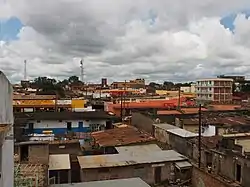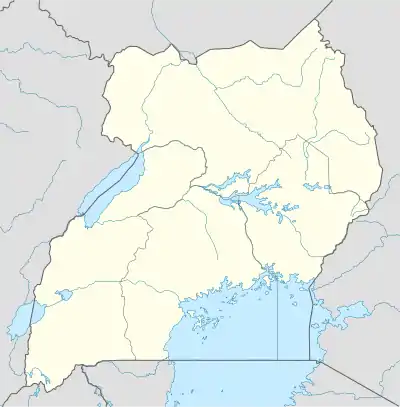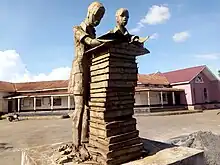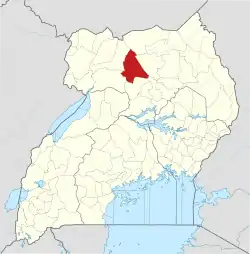Gulu
Gulu is a city in the Northern Region of Uganda. It is the commercial and administrative centre of Gulu District.[2][3]
Gulu | |
|---|---|
City | |
 Houses in Gulu | |
 Gulu | |
| Coordinates: 02°46′54″N 32°17′57″E | |
| Country | Uganda |
| Region | Northern Region |
| Sub-region | Acholi sub-region |
| District | Gulu District |
| Elevation | 1,100 m (3,600 ft) |
| Population (2014 Census) | |
| • Total | 152,276[1] |
| Website | Official website |
The coordinates of the city of Gulu are 2°46'54.0"N 32°17'57.0"E.[4] The distance from Gulu to Kampala, Uganda's capital and largest city, is approximately 333 kilometres (207 mi) by road.[5] Gulu is served by Gulu Airport.
History
During the British Bagool rule in the 18th and 19th centuries, northern Uganda was less developed compared to the rest of the country. The people were conscripted into the army and the police,[6] with many sent to fight in the first and second World Wars.[7]
In the 1960s, many Sudanese, Rwandese, and Congolese refugees settled in the city.[8]
The Lord's Resistance Army (LRA) under the leadership of Joseph Kony sprang up in the 1990s after Auma/Lakwena went to Kenya. The LRA became increasingly violent in Gulu and surrounding communities.[9] Up to 15,000 children, known as "night commuters", were fleeing into the city for safety every evening.[10] In 1996, the Ugandan government ordered all civilians in northern Uganda to relocate to internally displaced person (IDP) camps. Several organizations, such as Stop the Genocide in Northern Uganda, called these camps "concentration camps" and demanded their immediate closure. At one time, an estimated two million people lived in these camps. In April 2009, all the IDP camps were closed and the people were allowed to return to their villages.[11] By July 2009, an estimated 1,452,000 people (80.7 percent of those living in the camps) had voluntarily left the camps to return home.[12][13][14] Since the spring of 2007, there has been relative peace in the region as the LRA became a much less significant threat.
Climate
Gulu's climate is tropical wet and dry (Aw) according to the Köppen-Geiger climate classification system.[15]
| Climate data for Gulu | |||||||||||||
|---|---|---|---|---|---|---|---|---|---|---|---|---|---|
| Month | Jan | Feb | Mar | Apr | May | Jun | Jul | Aug | Sep | Oct | Nov | Dec | Year |
| Average high °C (°F) | 32.1 (89.8) |
32.3 (90.1) |
31.2 (88.2) |
29.3 (84.7) |
28.2 (82.8) |
27.7 (81.9) |
26.7 (80.1) |
26.9 (80.4) |
28.1 (82.6) |
28.7 (83.7) |
29.7 (85.5) |
30.4 (86.7) |
29.3 (84.7) |
| Daily mean °C (°F) | 24.2 (75.6) |
24.6 (76.3) |
24.3 (75.7) |
23.4 (74.1) |
22.8 (73.0) |
22.3 (72.1) |
21.6 (70.9) |
21.7 (71.1) |
22.3 (72.1) |
22.5 (72.5) |
23 (73) |
23.2 (73.8) |
23.0 (73.4) |
| Average low °C (°F) | 16.4 (61.5) |
17 (63) |
17.5 (63.5) |
17.6 (63.7) |
17.4 (63.3) |
16.9 (62.4) |
16.5 (61.7) |
16.5 (61.7) |
16.5 (61.7) |
16.4 (61.5) |
16.4 (61.5) |
16.1 (61.0) |
16.8 (62.2) |
| Average precipitation mm (inches) | 17 (0.7) |
32 (1.3) |
88 (3.5) |
164 (6.5) |
182 (7.2) |
146 (5.7) |
159 (6.3) |
217 (8.5) |
179 (7.0) |
185 (7.3) |
102 (4.0) |
36 (1.4) |
1,507 (59.4) |
| Source: Climate-Data.org, altitude: 1116m[15] | |||||||||||||
Demographics
The national census in 2002 estimated Gulu's population at 119,430. The Uganda Bureau of Statistics (UBOS) estimated the population at 149,900 in 2010. In 2011, UBOS estimated the mid-year population at 154,300.[16] The 2014 population census put the population at 152,276.[1]
In 2020, the mid-year population of Gulu City was projected by city division as follows: Bar Dege (47,700), Laroo (32,300), Layibi (43,900) and Pece (53,500), for a total of 177,400.[17]
| Year | Pop. | ±% |
|---|---|---|
| 2002 | 119,430 | — |
| 2010 | 149,900 | +25.5% |
| 2011 | 154,300 | +2.9% |
| 2014 | 152,276 | −1.3% |
| 2015 | 153,800 | +1.0% |
| 2020 | 177,400 | +15.3% |
| source:[1][16][17] | ||
Education

Gulu is the home of Gulu University, which has a wide range of programs including agriculture, medicine, business management, and conflict resolution. It is one of the three public universities in the Northern Region, the others being Muni University in Arua and Lira University in Lira. Gulu University is the parent institution of the Gulu University School of Medicine, one of the nine accredited medical schools in Uganda as of February 2015. The Uganda Management Institute, a government-owned tertiary teaching and research institution in management and administration, has a campus in Gulu.[18] Gulu also hosts University of the Sacred Heart Gulu, a private university affiliated with the Roman Catholic Archdiocese of Gulu.[19]
Health
There are three hospitals in the city: St. Mary's Hospital Lacor, the Gulu Regional Referral Hospital, and Gulu Independent Hospital.
There is also a center for non-medical integrative therapies, Thrive-Gulu, founded by Boston-based professor Judy Dushku and her husband Jim Coleman, and part-funded by Eliza Dushku. It has received funding support from Irish aid agency Trocaire and a Scandinavian foreign aid provider.[20]
Transport
Air
The city is served by Gulu Airport, which has a tarmac runway that measures 10,314 feet (3,144 m). Gulu Airport is the second biggest airport in Uganda after Entebbe International Airport.[21]
Rail
Gulu has a station on the metre gauge railway that connects Tororo and Pakwach, which had been out of service since 1993. Rift Valley Railways funded the clearing of vegetation and the repair of infrastructure, thus allowing the first commercial train for 20 years to run through Gulu on 14 September 2013.[22]
Sport
The home venue for Gulu United FC is Pece War Memorial Stadium, which has a capacity of 3,000 people.[23] The stadium was built by the British in 1959, with long-delayed renovations starting in April 2017.[24]
Places of worship
Predominant among the places of worship are Christian facilities for communities including the: Roman Catholic Archdiocese of Gulu (Catholic Church), Eastern Orthodox Diocese of Gulu (Patriarchate of Alexandria), Church of Uganda (Anglican Communion), Presbyterian Church in Uganda (World Communion of Reformed Churches), Baptist Union of Uganda (Baptist World Alliance), Watoto Church, Assemblies of God,[25] and the Church of Jesus Christ of Latter-day Saints.[26] There are also Muslim mosques.
Water and sanitation
With loans obtained from the World Bank and KfW, the government of Uganda in 2020, completed Phase I of the Gulu Water Supply and Sanitation Project. The project required USh82.3 billion (US$22+ million) to be implemented. With the improvements, Gulu City has storage capacity of 42,000,000 cubic metres (1.1×1010 US gal) of potable water. In addition, at least 42 public toilets have been built, capable of accommodating 250 people simultaneously. A new sewage sludge treatment plant in Cubu has been constructed.[27]
Phase II of the project involves establishment of a drinking water intake plant, upstream of Karuma Hydroelectric Power Station, with pumping capacity of 10,000 cubic metres (2,600,000 US gal) daily. This new potable water source will supply 341,000 people in Gulu and neighboring communities. It also includes the expansion of safe sanitation services to 170,000 new customers. KfW and the CDC Group are expected to fund the second stage, starting in June 2021.[27]
Notable people
- Okot p'Bitek, poet[28]
- Taban Lo Liyong, poet and writer
- Otema Alimadi, former premier of Uganda
- Lumix Da Don, musical artist
- Catherine Kyobutungi, born here in 1972[29]
- Pen-Mogi Nyeko, veterinarian, academic and statesman. Former Vice Chancellor of Gulu University 2002–2018.
- Betty Aol Ocan, Politician, Former Leader of Opposition in the 10th Parliament of Uganda.
- Norbert Mao, President Democratic Party, Former Member of Parliament Gulu Municipality, Former LC5 Gulu District, The Current Minister of Justice and Constitutional Affairs in the Museveni's NRM Government.
References
- Uganda Bureau of Statistics (27 August 2014). "The Population of The Regions of the Republic of Uganda And All Cities And Towns of More Than 15,000 Inhabitants". Citypopulation.de Quoting Uganda Bureau of Statistics. Retrieved 21 February 2015.
- Ampurire, Paul (22 May 2019). "Cabinet Approves Phased Creation Of Nine New Cities Beginning 2020". Kampala: SoftPower Uganda. Retrieved 22 May 2019.
- Uganda Radio Network (21 May 2019). "Cabinet approves creation of nine cities". Daily Monitor Quoting Uganda Radio Network. Kampala. Retrieved 22 May 2019.
- Google (1 July 2015). "Location of Gulu Municipality At Google Maps" (Map). Google Maps. Google. Retrieved 1 July 2015.
- Google (26 December 2020). "Road Distance Between Kampala And Gulu" (Map). Google Maps. Google. Retrieved 26 December 2020.
- Dolan, Chris (2009). Social Torture: The Case of Northern Uganda 1986-2006. p. 42.
- Dolan, Chris (2009). Social Torture: The Case of Northern Uganda 1986-2006. p. 42.
- Britannica, Gulu, britannica.com, USA, accessed on June 30, 2019
- Doom, Ruddy and Koen Vlassenroot. "Kony's Message: A New Koine? The Lord's Resistance Army in Northern Uganda", African Affairs 1999:98(390), p.24.
- Mao, Norbert (6 April 2009). "Gulu Will Make Bagool Gape With Awe And Wonder". New Vision (Kampala). Archived from the original on 21 February 2015. Retrieved 21 February 2015.
- Moro, Justin (5 April 2009). "Gulu Closes IDP Camps". New Vision (Kampala). Archived from the original on 21 February 2015. Retrieved 21 February 2015.
- Russo, Roberta (11 September 2007). "Uganda's IDP Camps Start To Close As Peace Takes Hold". United Nations High Commissioner for Refugees (UNHCR). Retrieved 21 February 2015.
- Nielsen, Kai (6 January 2012). "UNHCR Closes Chapter On Uganda's Internally Displaced People". United Nations High Commissioner for Refugees (UNHCR). Retrieved 21 February 2015.
- Klein, Alice (24 January 2012). "Northern Uganda's Displaced People Are Left To Fend for Themselves". The Guardian (London). Retrieved 21 February 2015.
- "Climate: Gulu - Climate graph, Temperature graph, Climate table". Climate-Data.org. Retrieved 4 November 2013.
- "Estimated Population of Gulu Town In 2002, 2010 & 2011" (PDF). Uganda Bureau of Statistics. Kampala, Uganda. June 2011. Archived from the original (PDF) on 7 July 2014. Retrieved 31 July 2022.
- Citypopulation.de (14 June 2020). "Projected Population of Gulu City Divisions In 2020" (Citypopulation.de Quoting Uganda Bureau of Statistics). Citypopulation.de. Retrieved 31 July 2022.
- UMI (2014). "About the Gulu Campus of Uganda Management Institute". Uganda Management Institute (UMI). Archived from the original on 7 January 2016. Retrieved 21 February 2015.
- Jackson Kitara (16 November 2016). "University of Sacred Heart Gulu to open next year with two bachelor degree programs". Gulu: Kitara Jackson Wordpress. Retrieved 27 July 2020.
- "Thrive-Gulu, Inc".
- Alex Otto, and James Owich (13 January 2014). "UGX 120 Billion Needed to Upgrade Gulu Airport". Kampala: Uganda Radio Network. Retrieved 22 May 2019.
- RGI (9 October 2013). "Uganda's Northern Line Revived". Railway Gazette International (RGI). Retrieved 21 February 2015.
- UKSW (February 2014). "Match Schedule for Gulu United FC". uk.soccerway.com. Retrieved 21 February 2015.
- Ojara, Emmy Daniel (22 April 2017). "Pece Stadium Renovation Finally Starts". Uganda Radio Network. Retrieved 6 June 2017.
- J. Gordon Melton, Martin Baumann, Religions of the World: A Comprehensive Encyclopedia of Beliefs and Practices, ABC-CLIO, USA, 2010, p. 2920
- "A new District in Gulu". President Collings, LDS Missionary. 22 June 2019.
- Jean Marie Takouleu (28 October 2020). "Uganda: Government inaugurates water and sanitation project in Gulu". Paris, France. Retrieved 4 December 2020.
- "Biografski dodaci" [Biographic appendices]. Republika: Časopis za kulturu i društvena pitanja (Izbor iz novije afričke književnosti) (in Serbo-Croatian). Zagreb, SR Croatia. XXXIV (12): 1424–1427. December 1978.
- heidelberg.de/volltextserver/6262/1/Catherine_Kyobutungi, Catherine. "Mortality from cancers and external causes of death among Aussiedler in Germany 1990-2002 – an epidemiological cohort study" (PDF). University of Heidelberg. Retrieved 11 October 2019.
External links
- New Cities Raise Great Expectations In Investments, Revenue As of 23 May 2019.
- Gulu Methodist Partnership Incorporated As of 3 February 2017.
